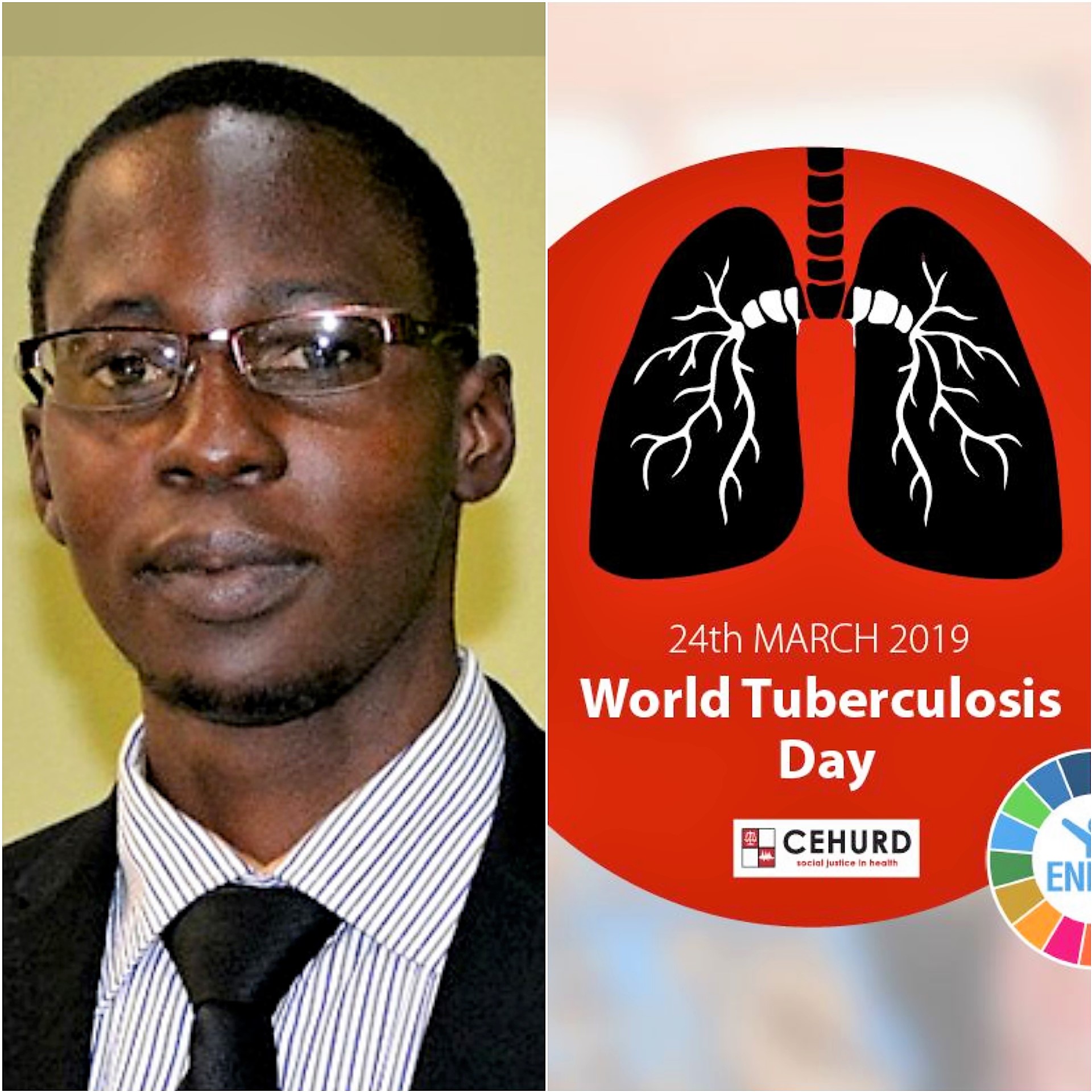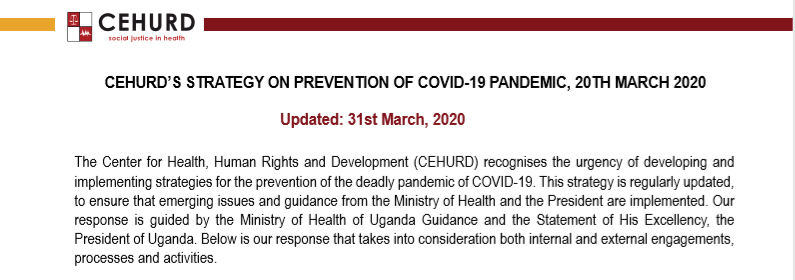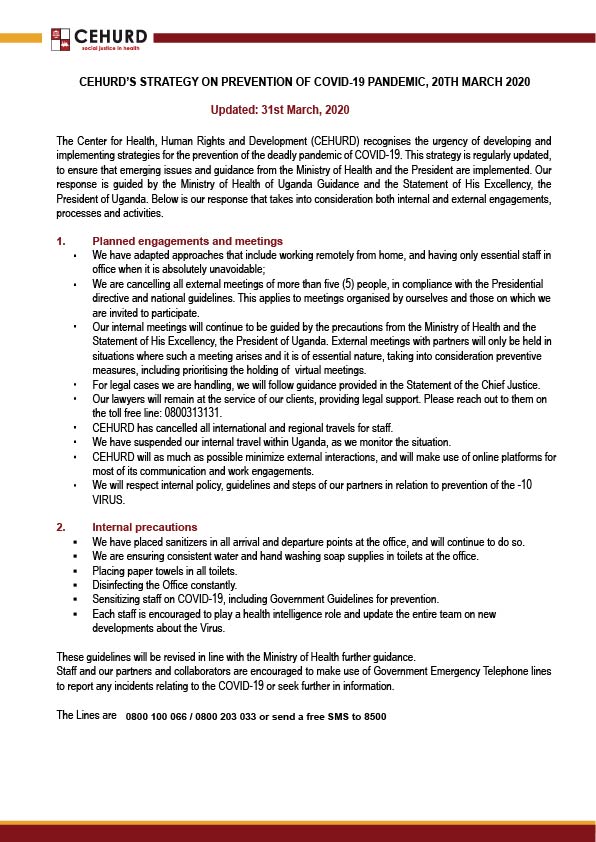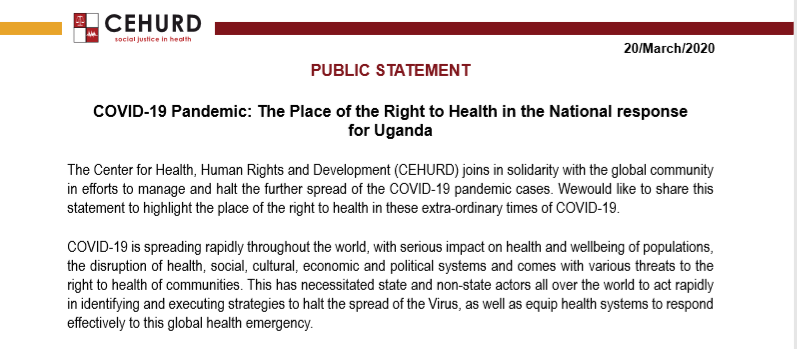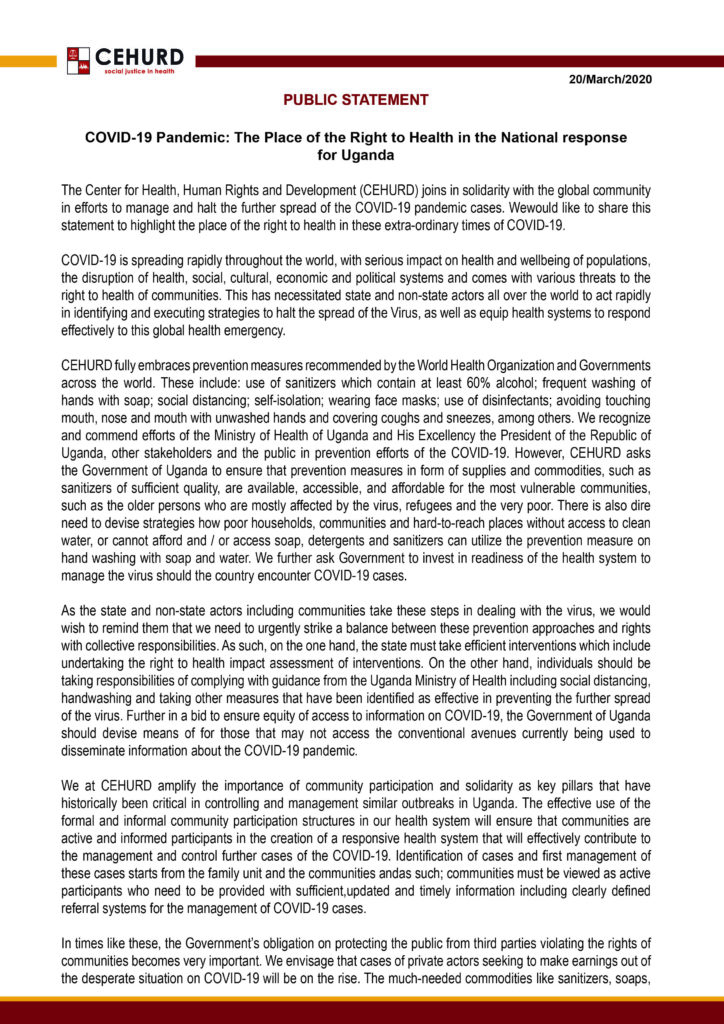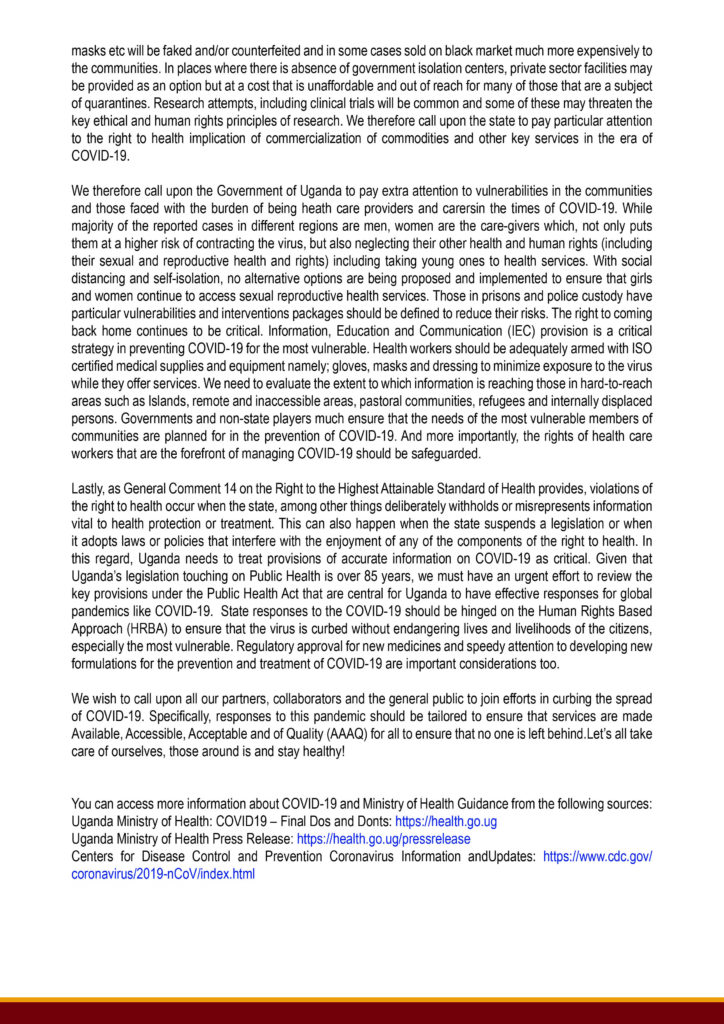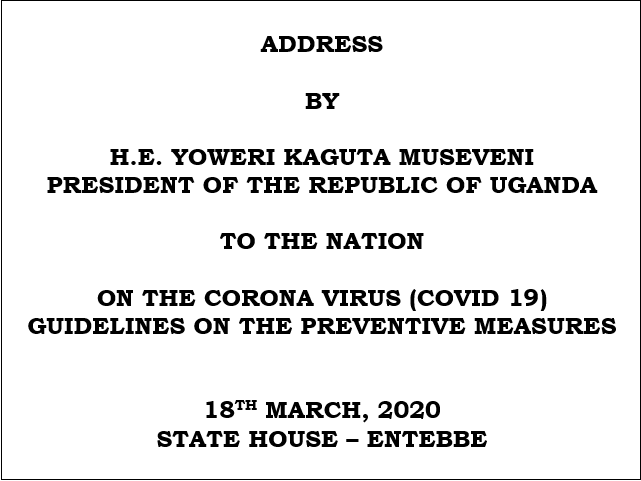Countrymen
and Countrywomen,
Greetings to you
all.
Today,
I have come to address you on the issue of the Corona virus, abbreviated as
Covid19. They call it corona because,
under the micro-scope, it looks like a crown (ekiruunga, engure). This is
a new virus but it belongs to the family of the common-cold (Senyinga, Rubyamira) group of viruses.
It makes some people very sick because, being a new virus, all of us do not
have immunity against it because we had never been exposed to it.
Fortunately,
after listening carefully to our scientists and after watching commentators in
the countries where it is already active, it seems to have two characteristics
that will help us to survive it and defeat it.
Characteristic number one, is that it does not kill many of the people
it infects. Out of the approximately
150,000 people that have been infected world-wide, only about 5,000 have died,
which works out at 3%. With Ebola in
Uganda, the percentage of the people dying was 67%. Secondly, this virus enters the body only
through the soft parts of the body: the nose, the eyes and the mouth.
It
cannot go through an intact skin like some of the diseases used to: yaws,
leprosy, etc.
This,
therefore, means that even when you get near a person with the virus in his/her
body, he/she can only infect you if he/she sneezes (Okwetsyamura) or coughs (Okukororra)
near you so that the tiny and invisible bimira
(mucous from the nose) or spittle (machwaante)
enter your nostrils or those infected materials from the body land on a surface
(a table, a chair, a door handle, a hand kerchief, etc.) where the virus can
stay alive for 3 hours and you, then, touch it and, then, touch your soft parts
of the body (the eyes, the mouth and the nose). It is this characteristic that
makes it very infective.
The
Cabinet, under my Chairmanship, on Monday, the 16th of March, 2020,
sat and decided as follows:
Although
the kill ratio of the virus is not very high compared to, for instance, Ebola,
this is if the victims are in perfect health. With the healthy young people,
for instance, some information says that an infected person may not even know
that he/she has any problem.
She/he
may defeat the virus without even knowing that it ever attacked him or
her. The real danger to society,
however, is for old people, 70 years and above and people with other diseases
they have been surviving with. Such
diseases are like: TB, HIV, diabetes, hypertension, etc. It is these that will
be very sick or even die. Since we have a very large number of people living
with HIV (1.4 million), having diabetes (800,00), hypertension (4.8m), TB
(100,000 per year), we must do everything possible to ensure that this enemy
does not come here, does not find plenty
of dry grass piled up and ready for flaming.
What is the dry grass that can help to start and sustain fire of a
corona-virus epidemic? It is the big masses of people, gathered together and in
close proximity.
What
are these masses of people that are gathered in groups that can easily aid the
spread of the virus? They are the following:
1. The students. The NRM has promoted
education. As a consequence, today,
there are 10.7million children in the Primary Schools; 2m children in the
Pre-Primary Schools; 2 million students in the Secondary Schools; 314,548
students in the Universities and Tertiary Institutions. This is a total of almost 15 million young
Ugandans, distributed in 36,285 Primary Schools (Government and Private), 7,308
Pre-Primary Schools (Government and Private); 5,553 Secondary Schools (Government
and Private) and 49 Universities and 1,543 Tertiary Institutions (Technical
Schools, Teacher Training Colleges, Vocational Schools), etc., etc. This is a total of 50,688 points with
concentrations of 1,000 or more persons each.
When I visited Masaka SS in Masaka Town, it had 4,000 pupils without
counting the other non-student people staying in that compound. It is wise that
we temporarily remove these concentration points by closing all the Primary and
Secondary schools as well as all the Universities and Tertiary Institutions for
one month, starting with Friday, the 20th of March, 2020, starting
at mid-day. All these institutions,
without exception, should close so that we deny this virus those
concentrations. The 42 million Ugandans
are divided into about 8million homesteads. Once the Educational Institutions
population goes home, they will disperse into these 8million homesteads that
have much less concentrations. If the
15million were to disperse equally into the 8million homesteads, each homestead
would take one and a half students. Since we cannot have a half a student, let
us correct to the nearest whole number and we end up with 2 students per each
homestead. It is a smart way of avoiding
these concentrations in the face of this danger. I have decided to close the
Educational Institutions even before the occurrence of a single corona incident
because I have observed the situation in other countries. Once the epidemic breaks out, there is so
much stampede that the first suspect to be affected is transport. You have seen how Airports were clogged with
people. That crowding is perfect ground
for new infections. Let us, therefore,
move early to avoid the stampede.
2. Once we deal with the concentrations in the
Educational Institutions, the next concentrations that we must deal with are
the religious gatherings: prayers in Churches, in Mosques, open air prayers and
services on Fridays, Saturdays and Sundays. In the interests of our people’s
health, these should be suspended for a month with immediate effect. Why with immediate effect? The answer is, a question of logic: “What if a person that is not yet infected
today with the virus is infected tomorrow, Thursday the 19th of
March, 2020, was to be infected in the last Service that had been called “to
pray for the last time?” How would God forgive us and how would we forgive
ourselves?” When it comes to health, it
is better to be a coward and be on the side of caution. If there is no danger after one month, that
will be good. If there was danger, we would have avoided it. The Prayers will
continue but in homes. The Religious leaders can use the TVs, Radios stations
to continue preaching. His Holiness, Pope Francis, as usual set a good example
of enlightenment on this by abandoning his customary preaching in St. Peters’
Square and is instead, using the TV.
3. Then the next category of mass meetings are
the political or cultural ─ Public rallies, conferences, elections, etc. All these are hereby forbidden for 32 days
with immediate effect.
4. Up to today, the 18th of March,
2020, Uganda, by the mercy of God, has been spared by not having even one case
confirmed of the corona-virus. There has been many false alarms that our
laboratories have proved false. However, there are countries in the world that
have had many cases. We describe these countries as category one countries in
terms of the epidemic. These countries
are: Italy, France, South Korea, China, USA, United Kingdom, Netherlands,
Switzerland, Sweden, Belgium, Germany, Spain, Norway Austria, Malaysia,
Pakistan and San Marino. We, with immediate effect, ban all out-bound movement
by Ugandans to or through these countries, again, for 32 days. Foreigners going to those countries are free
to do so provided they do not intend to come back within the prohibited
time. We extend our sympathies to those
countries and commend them for fighting on the behalf of the human race.
5. We cannot stop Ugandans coming back from
abroad, even from the category one countries that I read above. However, such Ugandans will be put in a
mandatory quarantine in a designated place but they will pay the cost for their
institutional quarantine ─ food, etc. If
they want to avoid that inconvenience or cost, they can sit out the storm in
the country of their temporary abode.
6. The next points of mass concentrations are
the non-agricultural work places: factories, hotels, large plantations,
markets, taxi-parks, etc. These should
continue functioning but with SOPs (Standard Operating Procedures) put out by
the Ministry of Health. These will include: compulsory hand-washing by all
persons who enter or exit those work places, anybody with symptoms of sickness
should not be allowed access for any reason, by the employers installing
temperature monitors. The Ministry will publish the detailed SOPs as part of
the Statutory Instrument to be signed by the Minister of Health with immediate
effect.
7. Then, the issue of Uganda-style weddings that
bring together a pentagon of groups: the clan members of the bridegroom (Kishweera); the clan members of the
bride (Kishwerwa, Omugore); the
maternal clans of the two couples (Obukojja
– Obwihwa); the school alumni of that couple; and the neighbours and
friends. These tend to be big gatherings of people coming from the 6 points of
the compass. This multi-directional source of the Mbagga attenders, can be as source of great danger. It is,
therefore, decided that the wedding of this type should be postponed for 32
days from today. If, however, the couples intending to marry are really in a
hurry, they could go for a purely scientific wedding, only involving the core
stakeholders who are: the bride-groom, the bride, the best-man, the assistant
to the bride (matron), the Priest (or the CAO), etc., as long as the number is
less than 10 people. The scientific
marriage could, then, later, at an appropriate time, be followed by the
Uganda-style one. Maama Janet and myself, used the scientific one in 1973 and
we have not regretted. The
“Corona-virus” that time was the Amin regime. Much, much later, with adult
children and grand-children, Janet and myself, were able to celebrate the 40th
anniversary of our marriage the Uganda-style with the whole Rwakitura compound
full of people, with our grand-children as the brides-maids. The impatient
intending couples could look at this model.
8. The other occasion that gathers alot of
people is a funeral. Again, relatives,
friends, associates, neighbours, etc., turn up in big numbers. Again, with this virus, this is a danger
point. Many people could be infected
there. We cannot ban or post pone
burials for 32 days. It would not be rational.
We, therefore, recommend that the burial is done by the relatives who
are nearby. They should be the ones to Kuziika (to bury). Then the mourning (the kukungubaga – ekyosi)
could be later when the rituals could be done. This may combine both science
and culture. Most importantly, it would
be safe for the participants. If the deceased is, however, suspected of dying
from the corona-virus, the State will take over and bury the person in the
scientific way without the involvement of the family as we did for the Ebola
victims. We should not replicate the lack of enlightenment that was exhibited
in West Africa where the ritual of washing dead bodies was maintained even when
people were dying from Ebola. The
consequence was that the “bathers of the dead bodies” ended up dying themselves
in service of a non-scientific cultural practice. By confronting this disease
with enlightened, scientifically based actions, we shall defeat it as we did
with Ebola three times, with Marburg and with AIDS.
9. The other big category of Ugandans are the
farmers ─ the crop people, the cattle keepers and the fishermen. These account
for 10million families according to the 2014 Census, with a population of 33
million people. These, however, may not
be a problem by themselves because they live in scattered homesteads and do not
allow much concentration of persons. If
they are not pulled by the Churches and Mosques or by politicians for political
rallies, they will go about their most useful activities in their dispersed
form that is not a danger to themselves or to others. However, they should all observe the hygienic
practices recommended in this and subsequent communications. The Technical
Committee on Health should, however, study more the issue of the fishermen.
Although they fish separately, they live in concentrated landing sites. The
Technical Committee will evolve the appropriate SOPs. With the other category of farmers (cattle
keepers and cultivators), the other danger area are the monthly markets. These
should also be suspended for the 32 days. Buying of crops and livestock
(cattle, goats, chicken, etc.), can go on but from the homesteads. They do not
have to congregate.
10. The next frontline with this virus is public transport
─ the boda-bodas, the taxis, the buses, the mini-buses and the trains. Everybody can see, the clear danger here, is
of many people sitting next to one another in the confined space of the vehicle
from Lira to Kampala etc. Therefore, the
advice here is: “Do not travel unless it is absolutely necessary, if you are
using public transport”. Additionally, the companies that operate these means
of transport should be given mandatory SOPs by the Ministry of Health:
hand-washing, not allowing sick people on board, temperature monitors etc. With these pre-cautions, public transport
will continue. However, in the event of
an outbreak in a given locality, public transport in that area will be
forbidden and the area will be isolated.
11. The next frontline of fighting the virus is to
stop the merry-making ─ the discos, the dances, bars, sports, music shows,
cinemas and concerts. These are very
dangerous gathering points with the virus around. Drunkards sit close to one
another. They speak with saliva coming
out of their mouth. They are a danger to themselves. All these are suspended for a month.
12. With these measures taken to deny the virus
mass concentrations of Ugandans, the next area to look at is Hygiene. The virus, according to the facts known so
far, spreads by okwetsyamura
(sneezing) and kukorora (coughing)
whereby, through your micro-mucous (ebimira)
or your spittle (otuchwante), you
pollute the air around you and the virus can now enter the nose of the nearby
people through breathing. That is why it
is important that anybody with a cough or cold should not go into public. You
should self-isolate yourself or be isolated by force, if you are not
responsible enough to govern yourself for the general good. Even at home, always cough or sneeze into a
handkerchief which you should frequently wash, dry and iron with a hot
flat-iron or use a disposable tissue which you should then, either flush in the
toilet or incinerate in a Sigiri. Do
not spray the public or your family with your mucous or spittle through
primitively sneezing or coughing without precautions or blocking your output in
the manner suggested. Once the
individuals control coughing and sneezing, then the next danger point is
touching surfaces with infected hands: tables, door-handles, telephone
hand-sets etc. Here, the answer is to cough and sneeze into the tissue which
you destroy so that your hands are not contaminated. In any case, you regularly wash these hands.
Therefore, your hands do not pollute the surfaces. With money in markets and Banks, the Ministry
of Health will publish SOPs governing that aspect, including disinfecting the
coins, using mobile money, using online purchases etc. Once you avoid open coughing and sneezing and
you wash your hands regularly, then you will not contaminate the surfaces ─ the
tables, the door handles etc. That will
protect the public. The virus, even if you have it, will remain with you until
you get healed. It is good that for some time now, we have stopped the practice
of shaking hands and hugging. There is also the side of everybody protecting
oneself. As you heard, the virus only
enters the body through the soft parts of the body: the mouth, the nose and the
eyes. Even if the surfaces are
contaminated with the virus and you touch those surfaces, yes the virus will be
on your hand. However, it will not enter
your body unless you touch yourself in the soft parts of your body before
washing. These soft parts are: the eyes,
the mouth and the nose. If you wash with soap, before you touch those soft
parts, the virus will die.
13. Then, there is the issue of nutrition so as to
eat foods that strengthen our body soldiers (the immune system) to fight the
enemy. Apart from ensuring a balanced
diet which the District Medical Officers, through fortnightly addresses to all
of you, should inform you about, in the particular fight against this virus,
there is the need to take in good quantities of Vitamin C, through eating
oranges and lemon and also eating ripe bananas to get folic acid and Vitamins
B6. The folic acid and the Vitamins B6 help the nervous system of the
body. Ascorbic acid from the oranges
helps your body to produce blood cells and build immunity. Therefore, apart from de-congesting
population concentrations so as to deny the virus big bodies of our citizens to
easily infect and spread, the other important measure is the one who is having
a cold not to spray the innocent with okwetsyamura
(sneezing) or coughing into the open air.
Block your sneezing with the tissue, if you are the rich type that can
afford tissues or into handkerchiefs that you frequently wash, dry and iron.
Wash your hands with soap so that you remove the virus on your hands so that
you do not contaminate the surfaces.
Then, on the defensive side, make it a habit never to casually touch
your mouth, your nose or your eyes with unwashed hands, in case you touched
contaminated surfaces. Eversince 1959, at Mbarara High School, when I attended
my confirmation course (Kitebwaho
emikono), the Reverend Yustus Ruhiindi advised us to use our left hand to
receive the bread for the Holy Communion because the right hand would have been
contaminated with the greeting of people.
It is now 61 years since. In all that time, my right hand is for greeting,
opening doors, handling pens etc. The
left hand is reserved for myself ─ blowing my nose, etc. This was long before these diseases ─Ebola,
Corona-virus, etc. It was a wise advice. The Ugandans could look at it. I never allow my right hand to touch my left
hand before washing. That is why I never
clap hands. I normally bang the tables
with the same right hand that I donated to the public long ago. I never want my
right hand to contaminate my left hand which is strictly for myself.
Otherwise, Uganda is prepared. We have isolation centres. We have
long had the testing capacity within the country eversince the first Ebola
days. We have some factories providing
hand sanitizers and we are going to have more.
Some factories will start producing face masks of the different
types. There is even some talk of
treatment using the old choloroquine.
However,
prevention is better than cure. On the side of the economy, there is no doubt
that some sectors like tourism, hotels, sports, entertainment, etc., will be
hit by the phenomenon of this disease.
However, others like the manufacturing sector will get a boost. The countries of the World, by their selfish
actions, are, again, waking up Africa that that it is ─ suicidal to depend on
others. I have warned our people to stop
talking like the selfish foreigners by trying to stop the little we have, being
exported to other African countries. We
can keep abit for ourselves but we shall share with the others whatever we
have. The blocking of imports should,
therefore, get the long-sleeping Ugandans to wake up and use the huge amount of
money they long earned by turning our market into a dumping point for foreign
goods to build our own manufacturing capacity.
Through the BUBU, we shall help those groups. Everything you have been importing, except
for petroleum products for now, now make here. The US$7bn you have been using
to import, keep it here. Turn misfortune
into an opportunity.
On
Saturday 21st March, the 41st Anniversary of the defeat
of Idi Amin’s forces at Rugando by the TPDF Force of 80 KJ and Task Force BN
and Fronasa Forces, I have invited the top leaders of the Faiths for National
Prayers at Entebbe State House. The few of us will pray for the whole country
together. All of you pray in your homes, God will hear us.
In order to synchronize the dates with the closure of the schools on Friday, the actions of suspending the other activities that are starting immediately will run for 32 days not 30 days.
Source: The State House of Uganda.


